
2018 iStock/Morsa Images
Older Americans feel their generation is discriminated against in the workplace and consider their own age to be a detriment when looking for a job. Additionally, about a fifth of workers age 50 and older feel they have been passed over for promotion or raises due to their age.
The 2019 Working Longer Survey explores the public’s view on age diversity in the workplace given the trend toward delayed retirement.
This trend of workers remaining on the job past the traditional retirement age of 65 is beneficial to the national economy according to 45% of Americans, and 39% say it’s good for workers in general. Among workers who have observed this trend in their own workplaces, nearly half say having more seniors at work is good for the culture of their workplace and the quality of work, and a third consider it good for their own career.
People age 50 and older are generally more enthusiastic about the increase in older people in the workplace than are younger people, particularly about its effect on their own career.
The nationwide poll was conducted February 14-18, 2019, by The Associated Press-NORC Center for Public Affairs Research with funding from the Alfred P. Sloan Foundation, using the AmeriSpeak Panel®, the probability-based panel of NORC at the University of Chicago. Online and telephone interviews using landlines and cell phones were conducted with 1,423 adults. The margin of sampling error is plus or minus 3.7 percentage points.
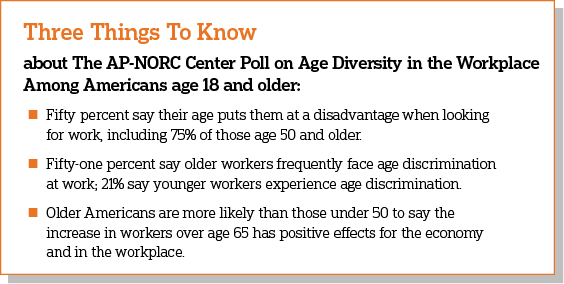
Key findings from the survey include:
- Fifty-eight percent of Americans age 50 and older say older workers frequently face age discrimination at work, and 44% of younger adults agree. Twenty-eight percent of American adults under age 50 say younger workers experience age-related bias at work, too, while only 13% of older people agree.
- Seventy-five percent of those age 50 and older think their age puts them at a disadvantage when looking for work, and only 6% say their age is an advantage. Of those age 18 to 49, 30% consider their age a hindrance when seeking a job, while 34% say their age is a plus. Adults under 30 are particularly inclined to see their age as a benefit: 47% say it is an advantage while 29% see it as a negative.
- Women age 50 and older are especially inclined to regard their age as a hindrance when job seeking. Seventy-nine percent of women and 70% of men age 50 and older say their age hampers their job search.
- Fifty-three percent of Americans age 50 and older say that people staying in the workforce past 65 is a plus for the national economy, and 50% say it is good for American workers in general. Younger Americans are less positive about this trend: 38% consider it good for the economy, and 30% say it is good for American workers.
- Forty-one percent of workers age 50 and older say the increase in older people in the workforce is a plus for their career, and 51% consider it advantageous for the culture in their workplace. Among younger workers, 27% say it is good for their career, and 43% regard it as a positive for their workplace culture.
- Younger workers are more likely to request accommodations like flextime or working remotely than are older workers. Forty-four percent of workers under age 50 have requested flexible hours. Women age 18 to 29 are most likely to ask for flextime.
Attitudes Toward the Increase in the Average Age of Retirement
From 1970 until 2000, older workers made up the smallest segment of the labor force. Older workers, defined by the Bureau of Labor Statistics as those age 55 and older, began to increase their share of the labor force in the 1990s, and by 2005 older workers made up a larger share of the labor force than those age 16 to 24.1
Nearly 6 in 10 employed Americans have noticed this trend of people working beyond the traditional retirement age of 65 playing out in their own workplace. But older workers are much more likely to say they are aware of the trend. Female workers, regardless of age, are also more inclined than their male counterparts to be aware of the increase in older people in the workforce (64% vs. 50%).
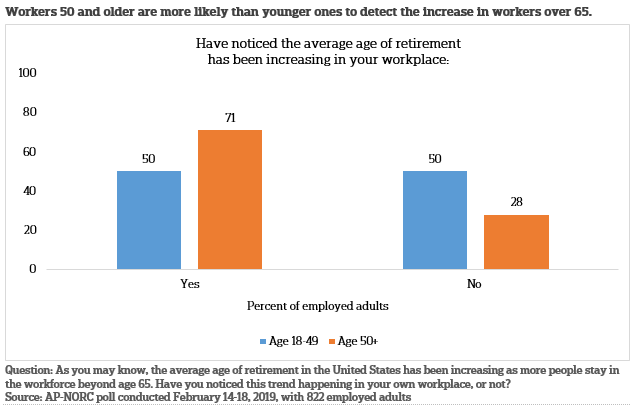
Asked to assess the impacts of this trend toward working longer, only about 30% of Americans consider it detrimental to the American workforce overall or the national economy.
Americans age 50 and older tend to view the impact of the trend more positively. While adults under 50 are less positive about the advantages of an aging workforce, those with a college education are even more negative about the growth of older workers. Forty-seven percent of adults under age 50 with at least some college education say people staying in the workforce is bad for workers in general, compared with 25% of those under 50 with no college education.
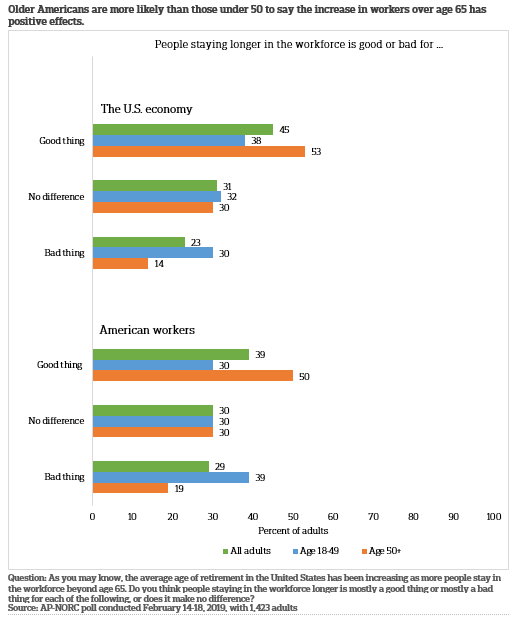
Similarly, among workers, those age 50 and older are more likely than younger workers to view additional older people at their workplace to be an advantage for their own career, their workplace, and its quality of work. While overall workers under 50 are less positive about the benefits of an aging workforce, again those with a college education are more negative. Thirty-seven percent of workers under age 50 with at least some college education say people staying in the workforce is bad for their career compared with 20% of young workers with no college education.
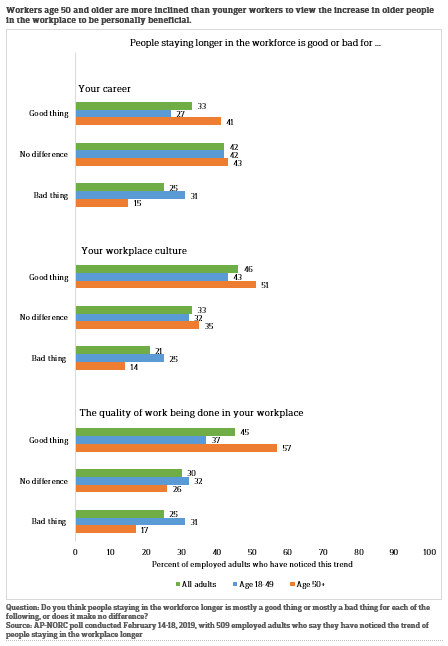
Age Discrimination and the Disadvantages of Age
Fifty-one percent of adults say older workers always or often experience age-based discrimination in the workplace, 39% say it happens sometimes, and 9% say older workers rarely or never experience prejudice based on their age.
Twenty-one percent say younger workers always or often experience age-based discrimination in the workplace, while 47% say it occurs sometimes, and 30% think it rarely or never happens.
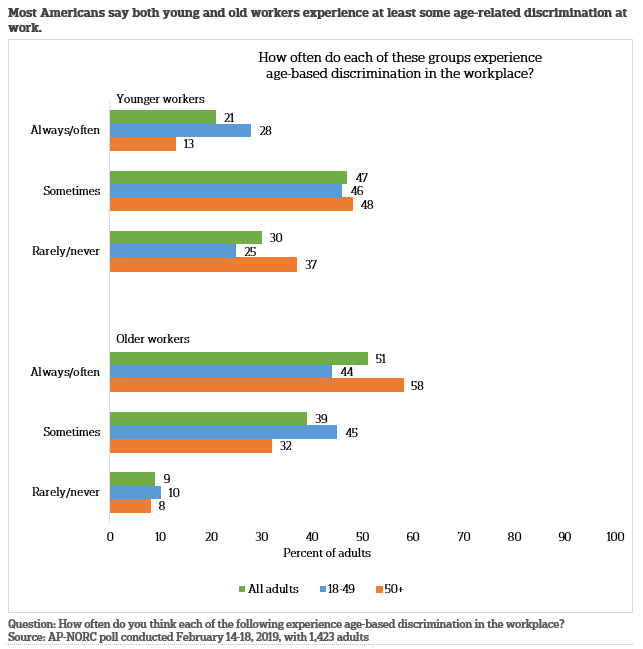
When it comes to finding a new job, half of Americans say their age puts them at a disadvantage. Among those age 50 and older, it is much more pronounced: 75% say it puts them at a disadvantage, 27% say it doesn’t make a difference, and only 6% consider their age a plus. Women age 50 and older are even more inclined still to regard their age as a hindrance when job seeking. Seventy-nine percent of women and 70% of men age 50 and older say their age hampers their job search.

More than a quarter of workers age 50 and older say they feel that they are respected more within their company because of their age, and nearly a fifth say they receive special assignments. On the negative side, nearly a fifth of older workers worry about their ability to handle their job and report having been passed over for promotions or wage increases because of their age. In addition, about 1 in 10 older workers say they haven’t received opportunities for training due to their age.
About 16% of both those under and over age 50 say they have been on the receiving end of age-related comments at work.
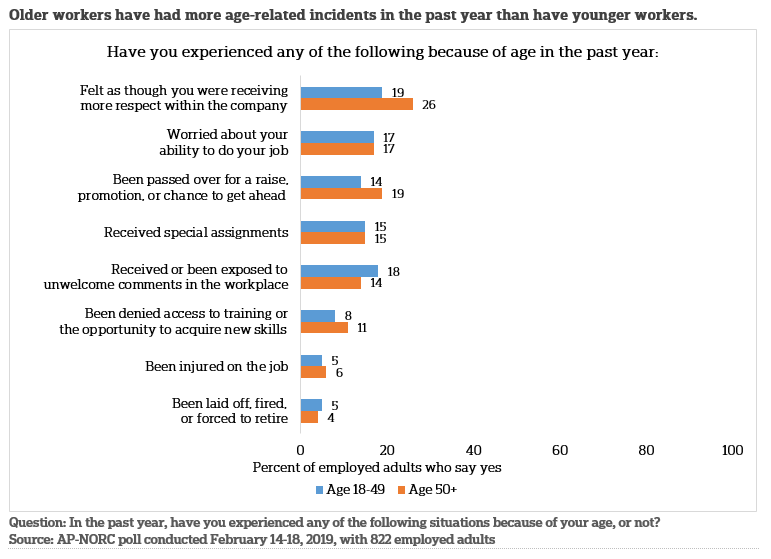
Accommodations at the Workplace
For the most part, few have ever requested accommodations at their workplace. One exception was flextime, which has been requested by 37%. Women in general and those age 18-29 in particular are most likely to have requested a flexible schedule. And among men, those who have at least some college experience are more likely to ask for flexible time than are other men. Overall, 79% say their request for flexible hours was granted.
Eighteen percent say they had requested working from home arrangements or sought a specialized workspace or equipment, and three-quarters of them got what they asked for.
Few have ever asked for adjustments to their hours or responsibilities, but most requests were accommodated.
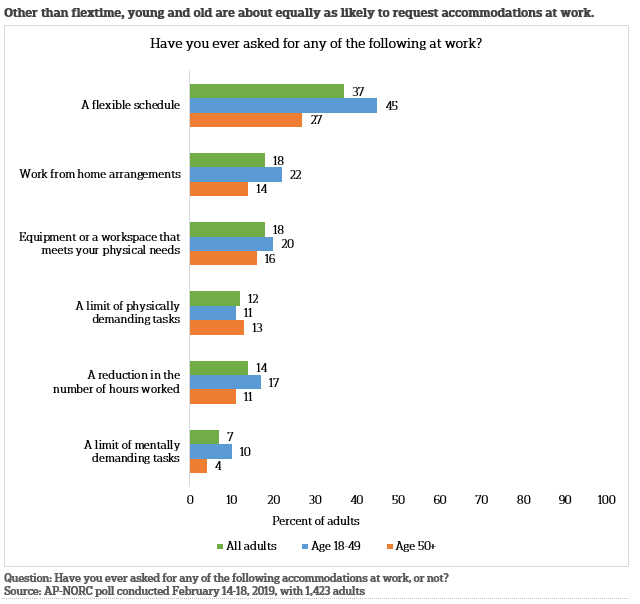
About the Study
Study Methodology
This survey was conducted by The Associated Press-NORC Center for Public Affairs Research and with funding from the Alfred P. Sloan Foundation. Data were collected using the AmeriSpeak Omnibus®, a monthly multi-client survey using NORC’s probability-based panel designed to be representative of the U.S. household population. The survey was part of a larger study that included questions about other topics not included in this report. During the initial recruitment phase of the panel, randomly selected U.S. households were sampled with a known, non-zero probability of selection from the NORC National Sample Frame and then contacted by U.S. mail, email, telephone, and field interviewers (face-to-face). The panel provides sample coverage of approximately 97% of the U.S. household population. Those excluded from the sample include people with P.O. Box only addresses, some addresses not listed in the USPS Delivery Sequence File, and some newly constructed dwellings.
Interviews for this survey were conducted between February 14 and 18, 2019, with adults age 18 and over representing the 50 states and the District of Columbia. Interviews were conducted in English. Panel members were randomly drawn from AmeriSpeak, and 1,423 completed the survey—1,224 via the web and 199 via telephone. The final stage completion rate is 29.6%, the weighted household panel response rate is 34.2%, and the weighted household panel retention rate is 85.1%, for a cumulative response rate of 8.6%. The overall margin of sampling error is +/- 3.7 percentage points at the 95% confidence level, including the design effect. The margin of sampling error may be higher for subgroups.
In addition, adults age 50 and older were sampled at a higher rate than their proportion of the population for reasons of analysis. The overall margin of sampling error for the 927 completed interviews with adults age 50 and older is +/- 4.1 percentage points at the 95% confidence level including the design effect.
Once the sample has been selected and fielded, and all the study data have been collected and made final, a poststratification process is used to adjust for any survey nonresponse as well as any noncoverage or under- and oversampling resulting from the study-specific sample design. Poststratification variables included age, gender, census division, race/ethnicity, and education. Weighting variables were obtained from the 2018 Current Population Survey. The weighted data reflect the U.S. population of adults age 18 and over.
For more information, email info@apnorc.org
Contributing Researchers
From NORC at the University of Chicago
Marjorie Connelly
Emily Alvarez
Tomas Okal
Andrew Soergel
Jennifer Benz
Trevor Tompson
From The Associated Press
Emily Swanson
Hannah Fingerhut
About the Associated Press-NORC Center for Public Affairs Research
The AP-NORC Center for Public Affairs Research taps into the power of social science research and the highest-quality journalism to bring key information to people across the nation and throughout the world.
- The Associated Press (AP) is the world’s essential news organization, bringing fast, unbiased news to all media platforms and formats.
- NORC at the University of Chicago is one of the oldest objective and non-partisan research institutions in the world.
The two organizations have established The AP-NORC Center for Public Affairs Research to conduct, analyze, and distribute social science research in the public interest on newsworthy topics, and to use the power of journalism to tell the stories that research reveals.
The founding principles of The AP-NORC Center include a mandate to carefully preserve and protect the scientific integrity and objectivity of NORC and the journalistic independence of AP. All work conducted by the Center conforms to the highest levels of scientific integrity to prevent any real or perceived bias in the research. All of the work of the Center is subject to review by its advisory committee to help ensure it meets these standards. The Center will publicize the results of all studies and make all datasets and study documentation available to scholars and the public.
Learn more at www.apnorc.org
Footnotes
1. Bureau of Labor Statistics https://www.bls.gov/careeroutlook/2017/article/older-workers.htm ꜛ
